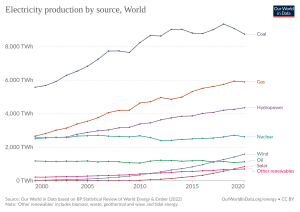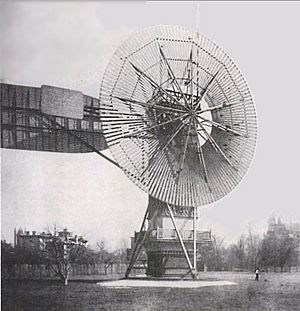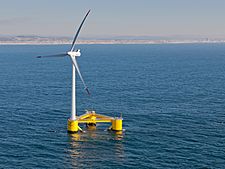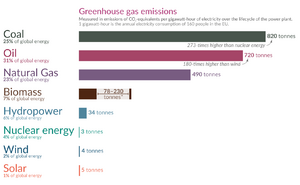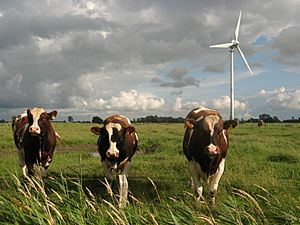Wind power facts for kids
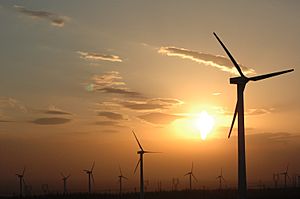
Wind power is all about using the energy from the wind to do useful things. Long ago, people used wind to power sails on ships, turn windmills to grind grain, and pump water with windpumps. But today, wind power is mostly used to make electricity. It's a sustainable and renewable energy source, which means it won't run out and it's much better for the environment than burning fossil fuels.
Contents
How Wind Power Started
People have used wind power for a very long time, ever since they first put sails on boats. Ancient writings, like King Hammurabi's Codex (around 1792-1750 BC), even talked about windmills.
Windmills and wind pumps, which grind grain and pump water, were first developed in places like what is now Iran, Afghanistan, and Pakistan by the 9th century. Wind power was used all over the world. For example, wind-powered pumps helped drain the lowlands in the Netherlands. In dry areas like the American mid-west or the Australian outback, wind pumps provided water for animals.
First Wind Turbines for Electricity
The very first windmill built to make electricity was in Scotland in July 1887. A professor named Prof James Blyth from Anderson's College built it. His wind turbine was about 10 meters (33 feet) tall and had cloth sails. It was in his garden and used to charge special batteries. These batteries then powered the lights in his house, making it the first house in the world to get its electricity from wind!
Blyth even offered to share the extra electricity with the people of Marykirk for their streetlights. But they said no, thinking electricity was "the work of the devil." Even though he later built another turbine for a hospital, his invention didn't become popular because people thought it wasn't cheap enough.
Around the same time, in Cleveland, Ohio, a bigger and stronger machine was built by Charles F. Brush in 1887-1888. This wind turbine had a rotor (the spinning part) that was 17 meters (56 feet) across and sat on an 18-meter (59-foot) tower. Even though it was huge, it only made 12 kilowatts of power. It charged batteries or powered up to 100 light bulbs and other machines in Brush's lab.
Wind Power Grows
As electricity became more common, wind power found new uses, especially for lighting buildings far away from central power plants. Throughout the 1900s, small wind stations were developed for farms and homes.
After the 1973 oil crisis, countries like Denmark and the United States started looking into bigger wind generators. These large turbines could connect to the main electrical grid and provide power to many homes. By 2012, the U.S. had enough wind power capacity to generate 60 gigawatts of electricity.
Today, wind-powered generators come in all sizes. From tiny ones that charge batteries in isolated homes to huge offshore wind farms that power entire cities.
Wind Farms and How They Work
Wind is simply air moving around in the Earth's atmosphere. To turn the energy of this moving air into mechanical energy, and then into electricity, we use wind turbines.
A wind turbine has a few main parts:
- Rotor: The part that spins.
- Blades: Usually three of them, attached to the rotor.
- Shaft: Connects the rotor to the gearbox.
- Gearbox: Speeds up the spinning motion.
- Generator: Turns the spinning motion into electricity.
- Tower: Holds everything up high where the wind is stronger.
When the wind blows, it pushes the blades, making the rotor spin. The spinning rotor turns a generator, which then creates electricity. This electricity is collected through special cables.
| Wind farm | Power (MW) | Country | More Info |
|---|---|---|---|
| Gansu Wind Farm | 7,965 | ||
| Muppandal wind farm | 1,500 | ||
| Alta (Oak Creek-Mojave) | 1,320 | ||
| Jaisalmer Wind Park | 1,064 |
Wind turbines are usually grouped together in places called wind farms. A wind farm is just a collection of wind turbines in the same area. Some very large wind farms can have hundreds of turbines! The land between the turbines can still be used for farming or other things. Wind farms can also be built far out in the ocean.
Most large wind turbines look similar. They have three blades that face into the wind, attached to a box called a nacelle on top of a tall tower.
Offshore Wind Power
Offshore wind power means building wind farms in big bodies of water, usually the sea. These farms are often less visible from land, which some people prefer. However, building and maintaining them in the ocean costs a lot more money.
As of late 2021, the Hornsea Wind Farm in the United Kingdom was the biggest offshore wind farm in the world.
Small-Scale Wind Power
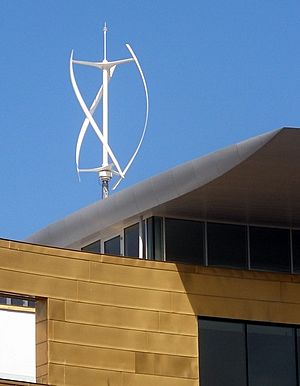
Small-scale wind power refers to wind systems that can make up to 50 kilowatts of electricity. These are often used in isolated communities that might otherwise rely on diesel generators. Individuals might also buy these systems to save money on electricity or to reduce their carbon footprint. For many years, people in remote areas have used small wind turbines with batteries to power their homes.
You can even find small wind power projects in cities! For example, in New York City, some buildings have installed special spiral-shaped wind turbines on their roofs since 2009. Even though they don't make all the power a building needs, they help show that the building is "green" and cares about the environment.
Impact on the Environment
Advantages of Wind Power
Wind power stations are much better than fossil fuel power stations because they don't produce harmful gases. They don't release carbon dioxide (a greenhouse gas) or gases that cause acid rain, like sulfur dioxide. This means they help keep our air cleaner and make the environment safer.
Disadvantages of Wind Power
Wind turbines need to be placed carefully. They must be in windy spots, but the wind can't be too strong, or it might damage the turbine. Because wind is natural and we can't control it, the amount of power wind turbines make can change. This means they might not always be a reliable source of energy on their own.
Large wind farms on land can also change the way a landscape looks. They often need a lot of space and are built away from cities. Some people worry that wind farms might spoil beautiful natural areas or important historical sites. A group in Scotland even said that wind farms hurt tourism in places known for their amazing views.
Wind farms can also affect wildlife. Sadly, thousands of birds and bats, including rare ones, have been killed by spinning turbine blades. However, wind turbines cause far fewer bird deaths than power stations that burn fossil fuels. Careful planning and monitoring can help reduce these problems for wildlife.
Many wind turbine blades are made of fiberglass and last about 20 years. But a lot of these old blades are hard to recycle, which is a challenge.
Interesting Facts About Wind Power
- In 2021, wind power made over 1800 TWh of electricity. That's more than 6% of the world's electricity!
- Wind power is one of the cheapest ways to make electricity.
- Areas closer to the North and South Poles often have the best wind for power generation.
- In most places, wind power works better at night and in winter.
- In 1919, a German scientist named Albert Betz discovered that a wind turbine can only capture about 59% of the wind's energy.
- Wind power can change, so during times with little wind, other power sources might be needed.
- It usually takes about a year for a wind farm to produce as much energy as was used to build it.
- About 1.25 million people worked in the wind power industry in 2020.
- Wind turbines make some noise. At about 300 meters (984 feet) away, it's like a refrigerator humming. But at 1.5 kilometers (about a mile) away, you usually can't hear them at all.
- Some people have reported health problems from living very close to wind turbines, but scientific studies haven't generally found strong evidence to support these claims.
- Unlike oil and gas, wind can't be "cut off," which helps countries have more energy security.
- Surveys in Europe and many other countries show that most people strongly support wind power.
See also
 In Spanish: Energía eólica para niños
In Spanish: Energía eólica para niños
Images for kids
-
Some people don't like how wind turbines, like these in Cumbria, England, look in the landscape.
-
A wide view of the Whitelee Wind Farm in the United Kingdom, with a reservoir in front.


